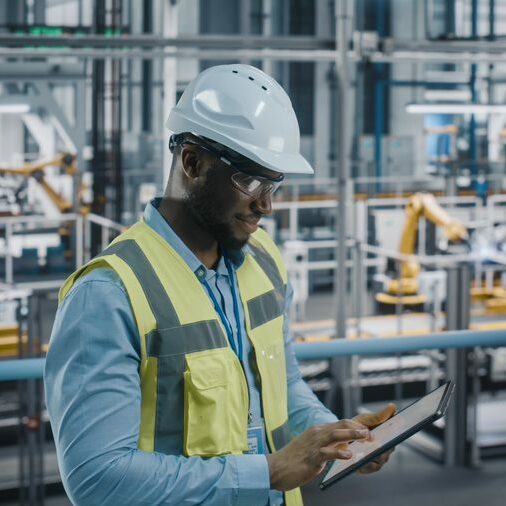Automation is at the center of modern manufacturing businesses, with companies exploring the possibilities of artificial intelligence in improving workflows and profitability.
AI technology is continually revolutionizing how equipment and humans operate on the manufacturing shop floor as well as improving the behind-the-scenes supply chain planning operations.
AI combines different technologies like neural networks, machine learning, and deep learning to improve the cognitive abilities of hardware and enable machinery to collect, analyze, and utilize data to enhance production workflow.
Industrial engineers incorporate these technologies in designing and fabricating advanced manufacturing systems.
These engineers develop machine learning algorithms that detect product anomalies, monitor equipment performance, and predict failures.
That way, companies achieve maximized equipment availability and deliver high-quality products.
Breaking Down the Definitions
AI: The theory and development of computer systems able to perform tasks normally requiring human intelligence, such as visual perception, speech recognition, language translation, and decision support systems.
Machine Learning: A branch of AI that is concerned with the question of how to construct computer programs that automatically improve with experience. So instead of being explicitly programmed or told what to do, you feed the program the data and it learns what to do.
Deep Learning: A family of machine learning methods based on neural networks architecture, that—due to recent advances in the ability to successfully train multiple layers of networks (“deep” networks)—have become the top performing algorithms in specific fields (computer vision, speech recognition, etc.).
Want to learn more about machine learning capabilities and their applications?
Check out Machine Learning 101.

But AI is not limited to the nuts-and-bolts operation.
By leveraging powerful machine learning, supply chain planners can better account for uncertainty, manage enormous swathes of data, and execute increasingly complex planning maneuvers.
How can the modern manufacturing company leverage an AI application to remain competitive despite increasing globalization, geopolitical disruptions, recurring supply chain interruptions, and pandemics?
Let’s delve into the five ways manufacturers are uncovering success by using AI to process information faster and perform more complex roles.
1. Optimizing Equipment Maintenance
Companies organize their maintenance schedules depending on the complexity of corrective measures, availability of workforce, and spare parts.
Sometimes equipment failures occur without notice. Unfortunately, equipment downtime causes financial losses of an estimated $50 billion a year.
That’s why companies in the manufacturing sector are shifting from reactive to data-driven maintenance strategies.

As AI becomes more affordable and accessible, manufacturers are leveraging the power of predictive algorithms in combination with sensors and computerized maintenance management systems (CMMS) to optimize their equipment maintenance.
The first step is accurate data collection.
AI-based condition-monitoring sensors are installed on critical assets to collect and relay valuable real-time performance data.
This data is critical for conducting failure mode and effect analysis (FMEA). It enables technicians to pinpoint defective parts and eliminate predominant or common equipment failures.
Using this data, advanced predictive models can estimate when failures are likely to occur and recommend appropriate timelines to perform corrective measures, allowing manufacturers to organize their production schedules based on predicted equipment availability metrics.

By employing these AI-based measures, manufacturers can:
- Optimize uptime
- Increase overall equipment effectiveness (OEE)
- Minimize production losses and defects
- Optimize spare part inventories
- Reduce facility-wide maintenance costs
In fact, companies save 25-30% of maintenance costs by leveraging predictive maintenance.
2. Performing Real-Time Quality Checks
As competition increases, companies worldwide focus on delivering quality products through lean manufacturing strategies.
They focus on process improvements, the elimination of waste, and real-time detection and correction of defects.
This plays a major role in quality assurance, an important factor in changing consumer behaviors. One study found that 51% of consumers prioritize product quality over price when making purchases.

To ensure quality control standards are met, modern production floors feature robots, sensors, and quality inspection cameras. These AI-based devices use machine learning to monitor production patterns.
In time, these systems combine different images to create a database for comparing product qualities.
Quality Inspection Cameras
High-resolution cameras with image recognition capabilities can identify the tiniest anomalies on a product’s surface.
Some of these defects are invisible to the human eye but can significantly affect the performance or safety of a product, making them an invaluable part of machinery inspection.
In fact, General Motors used AI-based cameras to detect anomalies in a robot assembly line, revealing 72 component failures.
Such technologies are vital for metal manufacturing and precision machining operations.
Computer Vision
Computer vision is an integral part of an AI system and assists manufacturers in conducting a quality inspection of finished products.
Keyence, a company based in Belgium, specializes in the design and supply of machine vision systems for automated inspection in different manufacturing facilities.
The systems are trained to identify patterns, colors, assembly elements, and flaws for real-time quality inspections.
Tracking anomalies using AI throughout the production process ensures manufacturers can manage production costs.
It also reduces the cost of conducting inspection checks since the systems can accurately monitor millions of products and document quality inspection reports automatically.
3. Using Computer Algorithms For Design and Production Planning
Manufacturers face several challenges as they strive to meet consumer demands.
There are increased calls for manufacturers to shift to sustainable processes. At the same time, consumer demands keep changing depending on product qualities, pricing, and supply chain constraints.
Companies must ensure shorter lead times and optimize their development and planning processes.
Computer-Aided Design Processes
Companies leverage advanced design solutions to expedite product design, rapid prototyping, and testing.
Computer-Aided Design (CAD) software developers use AI technology to optimize the product design process, using machine learning techniques for generative product designs.
When designing products using generative methods, computers leverage past data to identify recurrent design constraints. The system suggests appropriate manufacturing materials and fabrication methods and optimizes components for optimal functionality.
AI-based product design facilitates cheaper manufacturing and complements additive manufacturing strategies.
Production Schedules and Capacity Planning
Production schedules in most manufacturing facilities depend on the prevailing market demands, which change frequently. Companies must track these changes and adjust production schedules accordingly.
By employing production and capacity planning solutions with machine learning capabilities, manufacturers can run real-time simulations, analyze those results, and use the information to better execute advanced planning, scheduling, and production.
Manufacturers like Cerealis and Absolut incorporate production and capacity planning into their supply chain planning solution, helping planners optimize production resources and increase overall production efficiency.
Production and capacity planning can be part of an effective digital transformation within your supply chain. But it’s only one part of a digitalization plan.
With our partners at CSCMP, we surveyed 300 supply chain professionals from around the world.
Check out the 2022 Digital Transformation Survey to see how your industry peers are planning or implementing digital transformation strategies.

4. Maximizing Shop Floor Productivity
Artificial intelligence can keep things moving smoothly throughout the manufacturing process and maximize production efficiency through intelligent route planning and automated production.
Material Handling and Route Planning
Shop floor operations entail the movement of different goods from one point to another. Material handling is time-consuming and repetitive, and poor handling operations can cost manufacturers time and money.
Automating internal transportation activities eliminates production bottlenecks and increases productivity. To automate material-handling activities, companies use diverse AI-based technologies, including:
AGVs, robots, and AMRs can perform repetitive tasks without fatigue. They deliver goods at specific intervals and can handle hazardous materials.
AGVs are intelligent devices that follow a fixed path on the production floor. They contain multiple on-board sensors that detect guard rails or markings on the ground.
AMRs are designed for better flexibility and autonomous route planning. They are equipped with cameras, scanners, and lasers that use computer vision and machine learning to detect obstacles along the route and automatically change direction, determining the most efficient routes. These systems avoid paths with people, forklifts, production lines, or pallets.
The AGV and AMR market is expected to reach $18 billion as their demand increases in manufacturing.
Route Planning in the Real World
Additionally, supply chain managers use machine learning algorithms for route planning.
Before they dispatch delivery units, they collect GPS data to identify roads with massive traffic or regions with bad weather to identify the most efficient routes.
This ensures the manufacturer receives essential supplies and makes deliveries in good time.
Using Robots in Production
Using robots on the production line increases the productivity of the human workforce.
Robots are preferred for their high accuracy, fault detection capabilities (thanks to computer vision), automation of repetitive tasks, and high production speed. They can also perform multiple operations like sorting and packaging.
AI-based material handling facilities are cost-effective. They facilitate round-the-clock productivity on the factory floor.
Using robots, AMRs, and AGVs on the shop floor enhances productivity and ensures the manufacturer gains maximum returns on their investment.

5. Leveraging Machine Learning in Supply Chain Planning
Using AI for demand planning is vital for enhancing revenue growth, saving production costs, and freeing time for production planners, procurement teams, and supply chain managers to dedicate to value-added activities.
Machine learning systems are critical for managing increasingly complex supply chains and accurately predicting demand.
They collect historical sales data, scrape social media websites, monitor global financial data, and evaluate macroeconomic trends, weather, and inventory records.
A machine learning solution learns from this data and uses it to predict future demand more accurately, mitigating the effects of seasonality, new product introduction, and promotions on inventory.
This is a vital part of effective forecasting measures taken over the lifecycle of a product, ensuring reliable forecasting during the introduction, growth, maturity, and decline of an item and determining the beginning of each phase accurately.
Wondering what one of the biggest luxury car brands in the world has to say about machine learning?
Here’s what Nick Wilson, Senior Inventory Planner, Parts Operations at Aston Martin has to say.
“Thanks to ToolsGroup applying its new machine learning technology to our problem in a creative way, we’re now much better geared up to serve our demanding client base without impacting our bottom line.”
See what other supply chain practices you could be leveraging to boost profitability and ensure service.
Check out the 7-Step Guide to Supply Chain Planning Investments.

Final Words: The Case for AI in Manufacturing
AI technology is applicable in all aspects of the manufacturing industry, from design and production to supply chain planning. The prospects of its application in manufacturing are endless, and companies can utilize it to expand their operations and compete favorably against global players.
Industrial researchers are continually exploring methods to enhance machine learning algorithms to improve the functionality of production equipment.
But according to Deloitte, 91% of AI projects fail to meet expectations. Manufacturers should identify existing production gaps before choosing an appropriate AI solution.
Wondering how to spot those gaps?
Check out the Five Symptoms of Outdated Forecasting and Inventory Planning Software to pinpoint your supply chain’s vulnerabilities.

The source of this article is from ToolsGroup
By Erin Wagner

